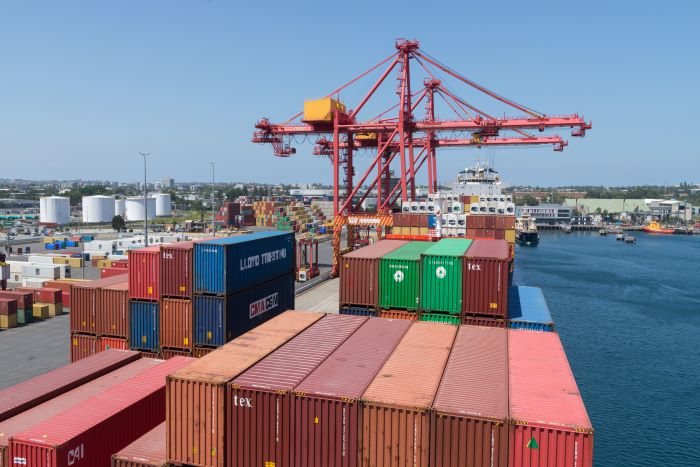

(This story has been updated to reflect surcharges and service adjustments announced by Hapag-Lloyd on Tuesday).
Australian shippers are outraged after Hapag-Lloyd, CMA CGM, ANL, and Mediterranean Shipping Co. announced plans to introduce an emergency port congestion surcharge on all containers to and from Sydney. That comes amid an escalating congestion crisis that has already led to delays of up to two weeks for some vessels, containers being diverted to Melbourne, and full container storage parks.
Hapag-Lloyd on Tuesday said it would introduce a raft of surcharges while also cutting services because of the problems at Sydney.
The carrier joined CMA CGM and MSC in announcing plans for a $300 per TEU congestion surcharge from September 16 on non-US trade lanes. The surcharge will be implemented from October 16 on US cargo after details are filed with the FMC.
The carrier will also apply a peak season charge of $300 per TEU and $600 per FEU on all cargoes from northeast Asia to Sydney from September 23 “because of the current delay into Sydney due to industrial action, congestion and weather conditions.”
Hapag-Lloyd said it would omit Sydney over the next six weeks on its South East Asia Australia Loop 2 service to “improve schedule reliability” due to the delays there.
In letters sent to the heads of CMA CGM/ANL and MSC in Australia late last week, Paul Zalai, director of the Freight & Trade Alliance (FTA), said customer notices advising of the surcharges have “sent outrage throughout the import, export, and international freight forwarding sectors.” The FTA has about 100 members, including Cargill, Kmart Australia, and Target. Zalai is also the secretariat of the Australian Peak Shippers Association (APSA).
The surcharges “will have a significant impact on landed costs and will leave many out of pocket due to downstream supply chain contractual agreements,” Zalai said in the letters.
MSC said it would impose a $300 per TEU surcharge on all boxes from September 14, although it will delay implementation for US cargo until October 8.
An MSC spokesperson told JOC.com the surcharge is being introduced “to compensate for costs related to the widely reported congestion and productivity situation at the port of Sydney.”
CMA CGM and subsidiary ANL said they would introduce a $285 per TEU congestion levy from September 17, although it would only apply to US cargo from October 10 to allow time for a filing to the US Federal Maritime Commission.
Highlighting the impact of MSC’s surcharge, Zalai said grain exporters will have to “absorb an extra A$17 ($12) per tonne of direct costs, making product uncompetitive in a global market and a devastating blow for an industry that already has locked in negotiated contracts with their overseas buyers.”
“The congestion charge has a bigger impact on exports which are generally high volume and low value so it has a huge impact on cost per tonne,” Zalai told JOC.com.
Labor action causing congestion
Neil Chambers, director of the Container Transport Alliance Australia (CTAA) which represents transportation interests, told JOC.com the delays have been caused by industrial action by dockworkers, exacerbated by berth congestion and bad weather at Sydney’s Port Botany.
Chambers said it is “unique” that dockworkers employed by all three terminal operators — DP World, Hutchison Ports Australia, and Patrick Terminals — are taking industrial action in support of new employment agreements and pay raises. DP World’s three other terminals, including in Brisbane, are also affected by industrial action.
Patrick Terminals said the compensation package sought by the Maritime Union of Australia would cost terminal operators about A$40 million a year and included a 6 percent annual pay hike over the next four years. Patrick Terminals said on Monday the industrial action “crippled” production at Port Botany, with just 60 crane teams working last week compared with about 100 normally.
CTAA’s Chambers raised the prospect the port disruption could widen to include Victoria International Container Terminal after the terminal agreement with wharfies expires at the end of October.
In the letters, Zalai said if the carriers’ stevedores “are not performing for whatever reason, it is our expectation [carriers will] be compensated by them rather than imposing a penalty [surcharge] on commercial clients.”
“While there is clearly a risk that other shipping lines may follow the MSC/CMA CGM lead, we trust that there has been no collusion between shipping lines and that alternate congestion surcharge-free options will be available for industry to make a decision for future transactions,” he added.
Raising the possibility of state and federal government probes into the surcharges, Zalai copied the letters to a raft of government officials and asked the Australian Competition and Consumer Commission (ACCC) to monitor the situation.
The ACCC is currently reviewing carriers’ block exemption from competition laws, with shippers calling for repeal of such exemption.
“Our immediate concern lies with importers and freight forwarders that have containers in-transit due to arrive and those exporters committed to coming voyages,” Zalai said.
CTAA’s Chambers thought the congestion in Sydney “will be ongoing for months, unless there is some circuit breaker that has the wharfies return to normal work routine still at the negotiation table.”
“As far as the empty container imbalance is concerned, it will take months to clear up the backlog,” he added.
Contact Keith Wallis.
